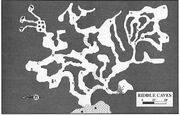
The Riddle-Caves and Ghost-Caves Terrain

The Riddle-Caves - Front Gate

Riddle-Caves - Map
During the mid-Second Age, the Daen Coentis, or "People of Skill," lived in the hills and vales at the foot of the White Mountains. They were the descendants of an ancient and noble Lintado race that had migrated over the plains of Rhovanion at the end of the First Age. These tribes crossed the Anduin and settled in the lands that would later become Gondor. There, they lived peacefully for many centuries, absorbing the older culture of the Druedain that had preceded them. The colonizing explorers of Numenor eventually drove the Daen into the mountainous interior, confining them to the valleys of the Ered Nimrais. Sauron's minions visited the superstitious tribes and subverted many by promoting cults rooted in the Dark Religion. The seeds of the oathbreaking had been sewn. The lowland Daen groups became friendly with the Numenoreans through proximity and necessity. They learned much from the newcomers, including advanced agricultural techniques and the concept of unified government. They eventually succeeded in electing a Council and a High-chieftain. Late in the Second Age, the High-chieftain of the lowland Daen Coentis swore an oath to King Elendil that his people would fight by the side of the Dúnadan armies should Gondor require allies in time of war. The highland Daen Coentis were greatly displeased with this pact, since they regarded the Dunedain as invaders, not neighbors. The priests of the highland tribes, long steeped in the traditions of the Dark Religion, aggravated the differences of opinion between the highlanders and thelowlanders. Dissension grew and fed on itself. When the Last Alliance of Men and Elves called for the warriors of the Daen Coentis to pit their weapons against Sauron at the close of the Second Age, their High-chieftain refused to honor his forebearer's promise. His refusal sealed the doom of the Daen Coentis. The Oath had been sworn, and the Daen would not be free of its bonds until they fulfilled it. Ore veins in their mines petered out, fields yielded no harvest, livestock sickened, craftsmen forgot crucial skills, and many women were barren. By night, apparitions of the dead roamed aimlessly near their burial sites. The thoughts of the Daen Coentis turned ever more towards death. To appease their gods, the priests sacrified eagles, serpents, and newborn lambs during worship ceremonies. The bloody rites proved ineffective, and stronger measures were tried. Human captives and then brave volunteers were ritually killed on the Daen altars. Individual warriors, followed by families and then whole tribes, left the area. By the third century of the Third Age, the Daen Coentis as a people no longer existed. The few who remained in the haunted Ered Nimrais dwindled and died. Most had migrated to the foothills of the southern Misty Mountains, where they became known as the Daen Lintis, the "Learned People," or the Dunmen. These tribes hoped that their escape from the land of the roaming dead had allowed them to also escape the curse laid on their ancesters. And yet perhaps the breaking of an oath by some may bring a curse upon the rest. Certainly, more troubles were destined to shadow their future. Sauron had further plans for his Dunnish minions. Conveyed through their tribal priests, the Dark Lord's will pushed the warriors to war on the men of Calenardhon. When the Great Plague in T. A. 1636-37 swept over the land, the minds of the Dunmen were stirred with fearful recollections of the Oathbreaking. They believed that the plague was a consequence of their ancestors' treachery, since this secluded people contracted the disease by their frequent raids upon Gondorian wagon trains. All among the foothills the Dunman tribes suffered. In an effort to escape the plague. Clan Gogafael entered an opening in the slopes of the Hithaeglir. The caverns connected to the Under-deeps, and the tribe rushed into the depths of the mountains, believing that there they would be safe. Behind them in the entry caves, they left a riddle to guard the secret of their flight. With them they took the wealth of the many that had perished around them. Clan Gogafael never surfaced from their subterranean hideout.
The Riddle Caves (D."Ogofau Hesgyno") were accessed from a flat shelf in the rocky crags of the northern side of the mountain spur north of Daithen. The edge of the forest lay at the elevation of 3,250 feet. Beyond this point, the cliffs steepened, rising another 4.000 feet in under four miles behind the cave entrance. Winds were strong on the shelf, making rock climbing dangerous if adventurers attempted to approach the caves by any way other than the road.
A small glade in front of a bare cliff wall, surrounded by heavy conifers, held the entrance to the Riddle Caves. A faintly worn road ran west from the mouth of the eight-foot-wide opening, and then forked amidst three boulder heaps. The mound of boulders closest to the spring bubbling at the foot of the cliff sheltered in its shadow a Pukel-man. He would move to stop anyone from getting near the cave. The cave entrance was Hanked by a pair of pillars. each carved with magical runes. Anyone who read the carved symbols on the pillars would flee in terror.
Everyone knew that there was a Riddle Cave in the nearby flank of the mountains, but most forgot that the cave led to the vaster caverns and crevices beneath the entire range.
